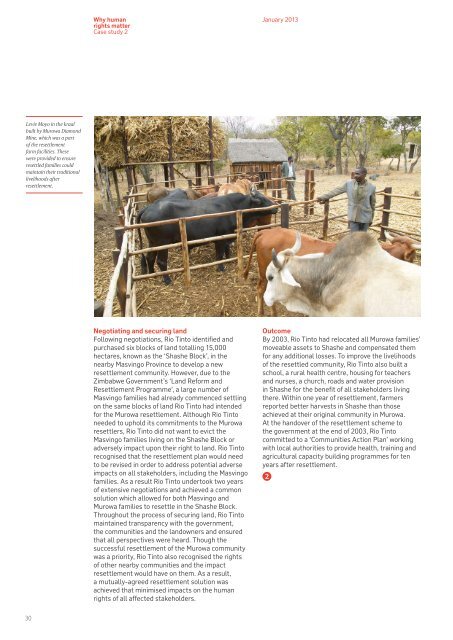Why human rights matter - Rio Tinto
Why human rights matter - Rio Tinto
Why human rights matter - Rio Tinto
You also want an ePaper? Increase the reach of your titles
YUMPU automatically turns print PDFs into web optimized ePapers that Google loves.
<strong>Why</strong> <strong>human</strong><br />
<strong>rights</strong> <strong>matter</strong><br />
Case study 2<br />
January 2013<br />
Levie Moyo in the kraal<br />
built by Murowa Diamond<br />
Mine, which was a part<br />
of the resettlement<br />
farm facilities. These<br />
were provided to ensure<br />
resettled families could<br />
maintain their traditional<br />
livelihoods after<br />
resettlement.<br />
Negotiating and securing land<br />
Following negotiations, <strong>Rio</strong> <strong>Tinto</strong> identified and<br />
purchased six blocks of land totalling 15,000<br />
hectares, known as the ‘Shashe Block’, in the<br />
nearby Masvingo Province to develop a new<br />
resettlement community. However, due to the<br />
Zimbabwe Government’s ‘Land Reform and<br />
Resettlement Programme’, a large number of<br />
Masvingo families had already commenced settling<br />
on the same blocks of land <strong>Rio</strong> <strong>Tinto</strong> had intended<br />
for the Murowa resettlement. Although <strong>Rio</strong> <strong>Tinto</strong><br />
needed to uphold its commitments to the Murowa<br />
resettlers, <strong>Rio</strong> <strong>Tinto</strong> did not want to evict the<br />
Masvingo families living on the Shashe Block or<br />
adversely impact upon their right to land. <strong>Rio</strong> <strong>Tinto</strong><br />
recognised that the resettlement plan would need<br />
to be revised in order to address potential adverse<br />
impacts on all stakeholders, including the Masvingo<br />
families. As a result <strong>Rio</strong> <strong>Tinto</strong> undertook two years<br />
of extensive negotiations and achieved a common<br />
solution which allowed for both Masvingo and<br />
Murowa families to resettle in the Shashe Block.<br />
Throughout the process of securing land, <strong>Rio</strong> <strong>Tinto</strong><br />
maintained transparency with the government,<br />
the communities and the landowners and ensured<br />
that all perspectives were heard. Though the<br />
successful resettlement of the Murowa community<br />
was a priority, <strong>Rio</strong> <strong>Tinto</strong> also recognised the <strong>rights</strong><br />
of other nearby communities and the impact<br />
resettlement would have on them. As a result,<br />
a mutually-agreed resettlement solution was<br />
achieved that minimised impacts on the <strong>human</strong><br />
<strong>rights</strong> of all affected stakeholders.<br />
Outcome<br />
By 2003, <strong>Rio</strong> <strong>Tinto</strong> had relocated all Murowa families’<br />
moveable assets to Shashe and compensated them<br />
for any additional losses. To improve the livelihoods<br />
of the resettled community, <strong>Rio</strong> <strong>Tinto</strong> also built a<br />
school, a rural health centre, housing for teachers<br />
and nurses, a church, roads and water provision<br />
in Shashe for the benefit of all stakeholders living<br />
there. Within one year of resettlement, farmers<br />
reported better harvests in Shashe than those<br />
achieved at their original community in Murowa.<br />
At the handover of the resettlement scheme to<br />
the government at the end of 2003, <strong>Rio</strong> <strong>Tinto</strong><br />
committed to a ‘Communities Action Plan’ working<br />
with local authorities to provide health, training and<br />
agricultural capacity building programmes for ten<br />
years after resettlement.<br />
2<br />
30
















![[PDF] Community Development Toolkit - CommDev](https://img.yumpu.com/48616495/1/184x260/pdf-community-development-toolkit-commdev.jpg?quality=85)
